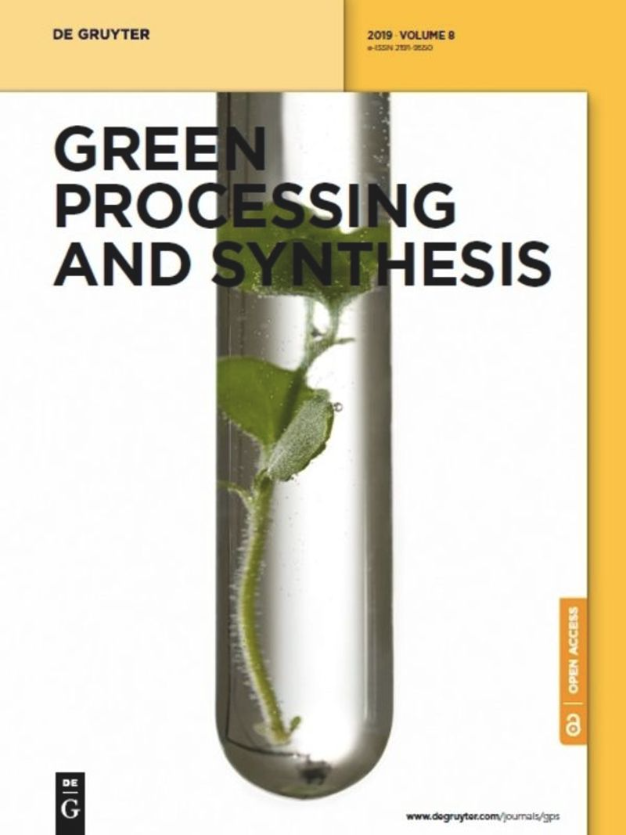Effect of phytogenic iron nanoparticles on the bio-fortification of wheat varieties
IF 3
4区 工程技术
Q2 CHEMISTRY, MULTIDISCIPLINARY
引用次数: 0
Abstract
Abstract Bio-fortification is a potential technique to tackle micronutrient deficiencies that remain. Wheat grain bio-fortification has the ability to decrease malnutrition because it represents one of the most essential staple crops. Bio-fortification is cost-effective and evidence-based sustainable technique to address malnutrition in wheat varieties possessing additional micronutrient contents. Nano-biofortification is a novel approach, enriching crops with essential nutrients in order to supplement human diets with balanced diets. The current study was designed to explore the potential role of phytogenic iron nanoparticles (Fe-NPs) to enhance nutritional contents in wheat plants to fulfill the nutrient deficiency important for human and animal health. In the current study, Fe-NPs were fabricated by using the extract of Mentha arvensis L. that were irregular in shape with an approximate size range of 40–100 nm. Further, Fourier transform infrared (FT-IR) analyses were deployed to confirm the presence of t of various functional groups involved in the green and eco-friendly fabrication of Fe-NPs. The effects of phytogenic Fe-NPs were examined on various physiological and biochemical parameters such as total proline, total chlorophyll, carbohydrates, protein, crude fibers, and lipids contents. Moreover, wheat physiological and biochemical profiling was carried out, and it was noticed that Fe-NPs significantly altered the physico-biochemical profiling of wheat plants. Multiple methods of administration of Fe-NPs were used to fortify the wheat crop. However, the Fe-NPs assisted seed priming along with foliar applications at various concentrations (10, 20, and 30 mg·L−1) were found more suitable to enhance the contents of proline, Chlorophyll a, b, total chlorophyll, carbohydrate, proteins, fibers, and lipids (20.22%, 18.23%, 17.25%, 16.32%, 12.34%, 24.31%, 19.52%, and 11.97%, respectively) in wheat plants. Further, wheat flour was exposed to digestive enzymes, with the iron content gradually increased in a dose-dependent manner. The nutritional analysis of wheat zinc (Zn), molybdenum (Mo), magnesium (Mg), iron (Fe), yttrium (Y), and copper (Cu) and the fatty acid profile have demonstrated divergent patterns of behavior. Similarly, iron content was also increased significantly in response to the exposure to Fe-NPs.植物源性纳米铁对小麦品种生物强化的影响
生物强化是解决微量营养素缺乏的一种潜在技术。小麦是最重要的主食作物之一,因此生物强化具有减少营养不良的能力。生物强化是一种具有成本效益和基于证据的可持续技术,可解决具有额外微量营养素含量的小麦品种的营养不良问题。纳米生物强化是一种新颖的方法,为作物提供必需的营养物质,以补充人类均衡的饮食。本研究旨在探讨植物源性铁纳米颗粒(Fe-NPs)在提高小麦植物营养含量方面的潜在作用,以弥补对人类和动物健康重要的营养缺乏。本研究以薄荷提取物为原料制备了形状不规则、尺寸约为40 ~ 100 nm的Fe-NPs。此外,傅里叶变换红外(FT-IR)分析被用于确认各种官能团的存在,这些官能团参与了Fe-NPs的绿色和环保制造。研究了植物源性Fe-NPs对总脯氨酸、总叶绿素、碳水化合物、蛋白质、粗纤维和脂质含量等生理生化指标的影响。此外,对小麦进行了生理生化分析,发现Fe-NPs显著改变了小麦植株的生理生化特征。采用多种施肥方法对小麦进行铁氮磷强化处理。结果表明,不同浓度(10、20和30 mg·L−1)Fe-NPs辅助种子处理对小麦植株脯氨酸、叶绿素a、b、总叶绿素、碳水化合物、蛋白质、纤维和脂质含量的提高效果更好(分别为20.22%、18.23%、17.25%、16.32%、12.34%、24.31%、19.52%和11.97%)。此外,将小麦粉暴露于消化酶中,铁含量以剂量依赖的方式逐渐增加。小麦锌(Zn)、钼(Mo)、镁(Mg)、铁(Fe)、钇(Y)和铜(Cu)的营养分析和脂肪酸谱显示出不同的行为模式。同样,铁含量也显著增加,以响应Fe-NPs的暴露。
本文章由计算机程序翻译,如有差异,请以英文原文为准。
求助全文
约1分钟内获得全文
求助全文
来源期刊

Green Processing and Synthesis
CHEMISTRY, MULTIDISCIPLINARY-ENGINEERING, CHEMICAL
CiteScore
6.70
自引率
9.30%
发文量
78
审稿时长
7 weeks
期刊介绍:
Green Processing and Synthesis is a bimonthly, peer-reviewed journal that provides up-to-date research both on fundamental as well as applied aspects of innovative green process development and chemical synthesis, giving an appropriate share to industrial views. The contributions are cutting edge, high-impact, authoritative, and provide both pros and cons of potential technologies. Green Processing and Synthesis provides a platform for scientists and engineers, especially chemists and chemical engineers, but is also open for interdisciplinary research from other areas such as physics, materials science, or catalysis.
 求助内容:
求助内容: 应助结果提醒方式:
应助结果提醒方式:


